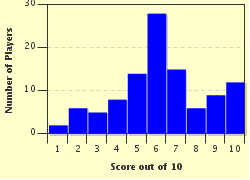Quiz Answer Key and Fun Facts
1. What method is used to color goofus glass?
2. EAPG is an acronym which means which of these terms in regard to vintage glass?
3. Typically, glass made from the early 1930s through the 1940s, usually with a pressed or finely molded (a.k.a. etched) pattern and in various colors, is referred to by collectors as what type of glass?
4. What metallic compound is added to molten glass to produce the lovely cranberry color sought by collectors?
5. How is pressed glass different from cut glass?
6. What do most glass collectors look for on hand blown glass to distinguish it from made-in-mold glass?
7. The most highly collectible early glass Christmas ornaments came from which country?
8. How did Carnival glass get its name?
9. Which of these terms is used to refer to items found inside glass that resulted from errors in the manufacture?
10. Sandwich glass was named from its use in serving food at tea parties?
Source: Author
debodun
This quiz was reviewed by FunTrivia editor
ozzz2002 before going online.
Any errors found in FunTrivia content are routinely corrected through our feedback system.

